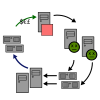Our website is made possible by displaying online advertisements to our visitors.
Please consider supporting us by disabling your ad blocker.
Wikipedia:Today's featured article/March 16, 2008
The Storm botnet is a botnet, a group of "zombie" computers controlled remotely. In September 2007, it was estimated to run on anywhere from 1 million to 50 million computer systems linked by the Storm Worm, a Trojan horse that has spread through e-mail spam. Other sources have placed the size of the botnet to be around 250,000 to 1 million compromised systems. The Storm botnet was first identified around January 2007, with the Storm worm at one point accounting for 8% of all malware on Microsoft Windows computers. The botnet reportedly is powerful enough as of September 2007 to force entire countries off the Internet, and is estimated to be able to potentially execute more instructions per second than some of the world's top supercomputers. Used in a variety of criminal activities, the Storm botnet has displayed defensive behaviors which indicated that its controllers were actively protecting the botnet against attempts at tracking and disabling it. The botnet has specifically attacked the online operations of some security vendors and researchers who attempted to investigate the botnet. It was revealed by one security expert, Joe Stewart, that in late 2007 the operators of the botnet began to further decentralize their operations, in possible plans to sell portions of the Storm botnet to other operators. Some reports as of late 2007 indicated the Storm botnet to be in decline, but many security experts reported that they expect the botnet to remain a major security risk online, and the United States Federal Bureau of Investigation considers the botnet a major risk to increased bank fraud, identity theft, and other cyber crimes. (more...)
Recently featured: Trapped in the Closet – Oxygen – Cretaceous–Tertiary extinction event
Previous Page Next Page



